The development of human therapeutics using gene editing technologies is an area of major interest that has recently received large public and private investments. The initial applications of gene editing technologies have largely focused on 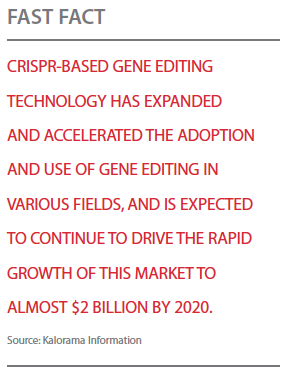 the treatment of monogenic disorders, but other areas, such as immuno-oncology, have also witnessed recently a growing interest from the biopharmaceutical industry.
the treatment of monogenic disorders, but other areas, such as immuno-oncology, have also witnessed recently a growing interest from the biopharmaceutical industry.
When Gregor Mendel first described the heredity of certain traits in his pea plants, he likely had no idea what his findings would lead to more than 150 years later, says Melissa Wang, Ph.D., senior medical writer at Ogilvy CommonHealth Medical Education, part of Ogilvy CommonHealth Worldwide.
“Fortunately, the tools for genome editing have improved rapidly in the past several years," she says. “With this powerful new gene-editing technology, what once took months, or even years, to achieve can now be completed in a matter of days with greater accuracy and fewer costs. Whereas the complexity of previous genetic engineering techniques restricted them to use in select organisms such as rodents, the simplicity of this new technology means that it can potentially be used in any organism, including humans. This revolutionary gene-editing technique has significant implications for society as a whole, arguably the most important of which is treating more than 10,000 human genetic disorders."
Gene editing technologies aim to use “molecular scissors" to make a cut in the genome and then DNA can be inserted, 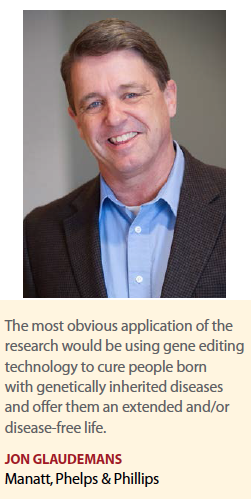 removed, or replaced.
removed, or replaced.
There are currently four families of engineered nucleases being used: zinc finger nucleases (ZFNs), transcription activator-like effector nucleases (TALENs), the CRISPR-Cas system, and engineered meganuclease re-engineered homing endonucleases.
Zinc fingers are the most well-known. But it is CRISPR-Cas9, the newest gene editing tool, that is getting the most attention. It uses a protein-RNA complex that has been designed to recognize a particular DNA sequence. This enables selective editing of defective genes and has the potential to allow safer, more precise gene modification.
CRISPR-Cas9 is tool modified from a bacterial immune system and is composed of two basic parts: the Cas9 protein, which acts like the wrench, and the specific RNA guides, CRISPRs, which act as the set of different socket heads. These guides direct the Cas9 protein to the correct gene, or area on the DNA strand, that controls a particular trait. The modifiable RNA sequence guides the enzyme directly to the desired gene, resulting in selective activation, repression, deletion, or modification of that gene.
Nature magazine has called CRISPR the biggest game-changer to hit biology since PCR.
“This is high praise considering that, in addition to winning a Nobel Prize, PCR is now ubiquitous in both research labs and on prime-time television crime dramas," says Ian DeMeritt, Ph.D., head of medical strategy, Fingerpaint.
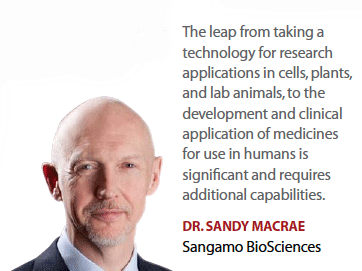 Dr. DeMeritt says CRISPR offers several key advantages.
Dr. DeMeritt says CRISPR offers several key advantages.
First, CRISPR is specific and simple.
“The ability to target Cas9 to specific nucleotide sequences is critical for studying the effects of individual genes, as well as repairing specific disease-causing mutations," he says. “Second, CRISPR doesn’t require complicated protocols, tools, or laboratory equipment.
Part of the power of this technology lies in the fact that just about anyone with basic molecular biology training can use it."
Dr. DeMeritt says third because of its ease of use, CRISPR offers significant cost savings over other gene-editing tools. Finally, and fourth, he says, the scope of applications for which CRISPR can be used ensures that it will have far-reaching utility and not be niched to a specific sub discipline.
“CRISPR is not only driving breakthroughs in basic science laboratories, but has broad applicability in industries ranging from drug development to agriculture," Dr. DeMeritt says.
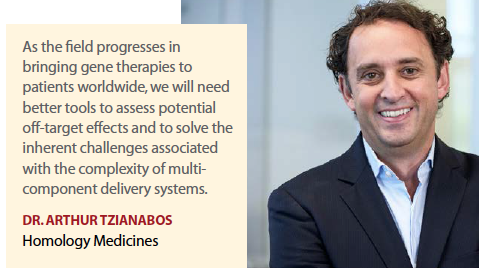 Gene editing embedded in older technologies, such as zinc fingers, has been around for some time, but these solutions have failed to impact biotechnology for several reasons, says Sam Falsetti, Ph.D., head of medical strategy and product innovation at Cambridge BioMarketing.
Gene editing embedded in older technologies, such as zinc fingers, has been around for some time, but these solutions have failed to impact biotechnology for several reasons, says Sam Falsetti, Ph.D., head of medical strategy and product innovation at Cambridge BioMarketing.
“Primarily, these applications were clunky in the sense that they were was not easy to deliver or leverage across multiple genes," he says.
“The new generation of gene editing, CRISPR-Cas9, uses a highly flexible system to let you basically pick any gene and target it in a specific manner for editing. The short take away is that if DNA is the code of the body CRISPR-Cas9 is a tool that lets you hack that code in a pretty universal way."
Dr. Falsetti says in the lab, this research can be used to create models of human genetic disease and improve preclinical science and drug discovery.
Beyond the lab, he says the technology platform can be used to “edit away" genetic diseases in humans and, potentially, genetically engineer crops, micro-organisms, and livestock.
The Power of CRISPR
CRISPR is a powerful gene-editing technology that is generating a lot of excitement in the biotechnology industry due to its potential role in human therapeutics.
“For as long as we have understood the genetic drivers of disease, we have been intrigued by the ability and theoretical possibility to affect permanent changes at the molecular level," says Lee Fraser, Ph.D., senior VP, group director science and medicine, Digitas Health LifeBrands. “With gene editing technologies approaching the mainstream, we can now begin to realize this potential. The specificity and precision with which gene editing can repair the genome is part of what makes it so revolutionary, and with CRISPR-Cas9, the simplicity and versatility provide the promise of practical clinical genetic manipulation in the near future."
CRISPR-Cas9 is radically simpler, cheaper and more potent than its predecessors, thus arming researchers with a powerful tool in their fight against many serious diseases, including cancer, says Chris Smyth, Ph.D., managing director, European and Asian Operations, Novella Clinical.
“The uses for the technology range widely from screening for potential drug targets to editing disease-causing genes and delivering those modified cells back to the patient as part of immune therapies," he says. “Discovery and development programs are under way, with the first CRISPR-Cas9 clinical trial to begin as early as this year. The promising technology has the potential to improve upon the more traditional gene therapy approaches, which have faced safety and efficacy challenges."
CRISPR makes gene modification possible in almost any type of cell, says Paul Dabrowski, CEO of Synthego.
“A much simpler tool than previous gene editing techniques, it is creating a huge new breadth of research possibilities for scientists that is also more precise than previous genome research and discovery tools, making it safer for use with precious cells," he says. “Coupled with advancements in available products, such as synthetic guide RNA — sgRNA — which Synthego has developed, these world-class tools speed up research, make it more consistent, and help scientists 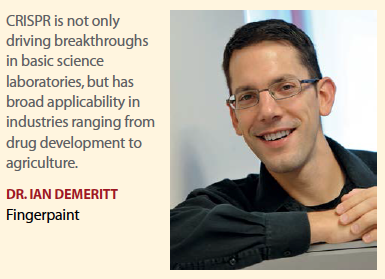 focus on understanding biology and curing diseases rather than diagnosing why an experiment didn’t work."
focus on understanding biology and curing diseases rather than diagnosing why an experiment didn’t work."
Synthego is a provider of genome engineering solutions. The company’s flagship product, CRISPRevolution, is a portfolio of synthetic RNA designed for CRISPR genome editing and research.
Gene editing has the potential to cure disease by addressing the underlying genetic cause, says Arthur Tzianabos, Ph.D., president and CEO, Homology Medicines.
“It offers patients suffering from devastating diseases and the healthcare system a permanent solution that has not been possible with current treatments," he says.
Homology, which was founded in May 2016 with a $43.5 million Series A preferred stock financing co-led by 5AM Ventures and ARCH Venture Partners, is a genetic medicines company translating proprietary, next-generation gene editing, and gene therapy technology into novel treatments for patients with rare diseases. Homology has built foundational IP on gene editing and gene therapy vectors derived from naturally occurring human adeno-associated viruses (AAVs).
Homology Medicines’ approach, called AMEnDRTM (AAV-Mediated Editing by Directed Homologous Recombination) technology, can correct and edit a gene mutation through in vivo delivery of a single AAV vector.
Gene Editing Application in the Life Sciences
The global market for gene editing technologies is a young market that is expanding rapidly as the technologies find a 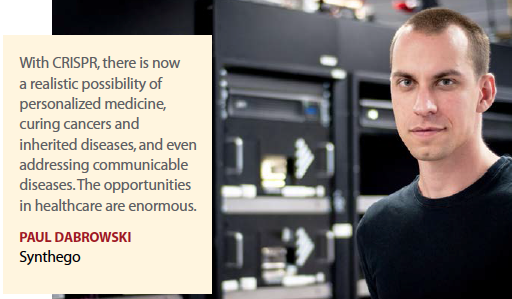 multitude of commercial applications in fields such as biopharmaceuticals, agriculture, and industrial products, according to a recent report from Kalorama Information. The market was valued at $382.9 million in 2015.
multitude of commercial applications in fields such as biopharmaceuticals, agriculture, and industrial products, according to a recent report from Kalorama Information. The market was valued at $382.9 million in 2015.
Growth is fueled by the growing awareness among scientists of applications of these technologies in fields including biopharmaceutical, agricultural, and industrial products. The CRISPR-based gene editing technology has expanded and accelerated the adoption and use of gene editing in various fields, and is expected to continue to drive the rapid growth of this market to nearly $2 billion by 2020.
Dr. Wang says gene-editing tools such as CRISPR have myriad potential applications in various fields, such as agriculture and biomedical research, and the most obvious gene therapy. According to the World Health Organization, scientists estimate that there are more than 10,000 genetic diseases where the mutation of a single gene is the underlying cause.
In healthcare, a tool like CRISPR could be used to directly target the mutated gene, fixing the specific mutation or even replacing the mutated gene with a fully functional one, she says.
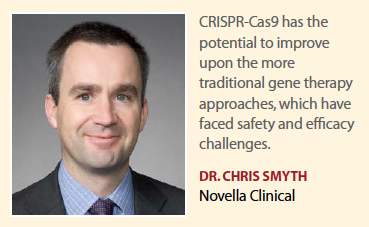 “This could have significant implications for genetic diseases ranging from hemophilia to sickle cell anemia to cancer," Dr. Wang says. “In fact, clinical trials utilizing this new technology in humans have already been approved. Initial modifications of genetic disorders such as Tay-Sachs disease or cystic fibrosis in human embryos are a small step away from more cosmetic genetic customizations such as height, weight, or eye color."
“This could have significant implications for genetic diseases ranging from hemophilia to sickle cell anemia to cancer," Dr. Wang says. “In fact, clinical trials utilizing this new technology in humans have already been approved. Initial modifications of genetic disorders such as Tay-Sachs disease or cystic fibrosis in human embryos are a small step away from more cosmetic genetic customizations such as height, weight, or eye color."
Much of the current research has been around disease, therapeutics, and drug discovery, and all look very promising to advance the field, Mr. Dabrowski says.
“With CRISPR, there is now a realistic possibility of personalized medicine, curing cancers and inherited diseases, and even addressing communicable diseases," he says. “The opportunities in healthcare are enormous, let alone applications in synthetic biology, plant research, and basic sciences."
Pharmaceutical and biotechnology companies have invested large sums of money in CRISPR, and the public health potential has caught the attention of powerhouse philanthropists such as Bill Gates.
“However, the benefits of CRISPR-Cas9 are not limited to its gene editing functions," Dr. DeMeritt says. “CRISPR also has immense potential as a type of molecular GPS. By disabling Cas9 so that it no longer cuts DNA, CRISPR has been turned into a precise targeting system that can be used to regulate individual genes, or groups of genes, turning them on and off by acting as a sort of molecular switch.
Harnessing Cas-9 in this way is helping to determine the role that specific genes play in various diseases, such as Alzheimer’s disease."
The potential applications of this research are numerous in treatment and cure of diseases caused by genomic changes. Specifically, many researchers are using CRISPR-Cas9 to examine the role of these genes in cancer development in order to identify targets against which therapies could be developed.
For example, Project Achilles, a large-scale screening effort by the Broad Institute and the Dana-Farber Cancer Institute, is using gene editing to silence individual genes in 500 cancer cell lines derived from both solid and hematopoietic tumors. The goal of this project is to discover targets that may lead to better therapies and to identify corresponding patient populations that might benefit.
Meanwhile, the National Cancer Institute is using CRISPR-Cas9 to screen genes involved in lymphoma cells to differentiate between those that drive cancer growth versus those that might be innocuous.
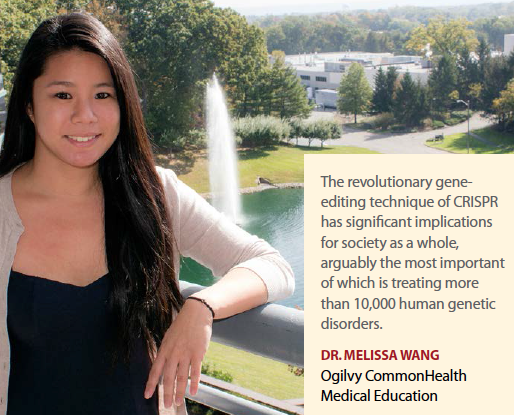 “Studies such as these can be conducted in cell lines but some may mature into animal models for examination of the disease process or treatments in living organisms," Dr. Smyth says. “Traditionally, creating such animal models was difficult because it meant modifying the DNA in germ line cells to generate diseased offspring."
“Studies such as these can be conducted in cell lines but some may mature into animal models for examination of the disease process or treatments in living organisms," Dr. Smyth says. “Traditionally, creating such animal models was difficult because it meant modifying the DNA in germ line cells to generate diseased offspring."
Now, with CRISPR-Cas9’s dramatic reductions in the time and costs required, this new technology can edit a mouse’s somatic cells to produce a much more robust and representative animal model of carcinogenesis, according to Jennifer Doudna, Ph.D., a co-discoverer of the gene-editing technology, in an editorial in JAMA.
Already, 17 cancer mouse models using CRISPR–Cas9 based genome editing have been catalogued, Dr. Smyth says. These cover lung, liver, and pancreatic cancers, as well as Burkitt lymphoma, acute myeloid leukemia, and glioblastoma.
CRISPR-Cas 9 has become a key tool for research laboratories around the world, accelerating basic research into cell function, says Sandy Macrae, Ph.D., president and CEO of Sangamo BioSciences.
“We have been able to read our genomes for decades; with the advent of genome editing, we now also have the ability to rewrite them," he says. “With that ability comes the potential to use the technology to provide benefit to patients. Genome editing technology enables us to precisely knock out a gene in a cell, or, in a targeted fashion, to add in a specific DNA sequence — be it a few base pairs to correct a mistake or an entirely new replacement gene."
Dr. Macrae says genome editing technologies such as CRISPR-Cas 9 and ZFNs have also simplified the generation of cell lines and transgenic animals for medical research and biologics manufacturing and are being used to streamline the process by which we improve crops to help feed a growing world.
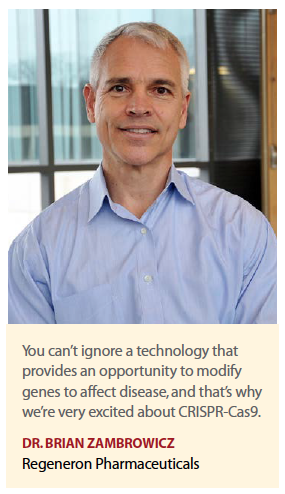 “However, the leap from taking a technology for research applications in cells, plants, and lab animals, to the development and clinical application of medicines for use in humans is significant and requires additional capabilities," he says. “Sangamo has forged that path and took the first therapeutic genome editing application into clinical trials in 2009. We are developing ZFNs as therapeutics because we believe that this protein-based technology provides the greatest potential for the design of highly specific genome editing medicines that can potentially provide life-long therapeutic benefit for patients."
“However, the leap from taking a technology for research applications in cells, plants, and lab animals, to the development and clinical application of medicines for use in humans is significant and requires additional capabilities," he says. “Sangamo has forged that path and took the first therapeutic genome editing application into clinical trials in 2009. We are developing ZFNs as therapeutics because we believe that this protein-based technology provides the greatest potential for the design of highly specific genome editing medicines that can potentially provide life-long therapeutic benefit for patients."
Sangamo’s proprietary ZFN-mediated in vivo genome editing approach is focused on monogenic diseases, including hemophilia and lysosomal storage disorders. Based on its in vivo genome editing approach, Sangamo is initiating a Phase I/II clinical trial for hemophilia B, the first in vivo genome editing application cleared by the FDA.
In addition, Sangamo has an ongoing Phase II clinical program to evaluate the safety and efficacy of novel ZFP therapeutics for the treatment of HIV/AIDS (SB-728). The company has also formed a strategic collaboration with Biogen for hemoglobinopathies, such as sickle cell disease and beta-thalassemia, and with Shire to develop therapeutics for Huntington’s disease.
“The focus of in vivo therapeutic genome editing applications today are applications to address monogenic diseases such as hemophilia, lysosomal storage disorders, and diseases of the eye," he says. “In the future, as technologies improve and we establish the safety of genome editing one could envision that we will develop genome editing therapeutics for conditions caused by multiple gene defects.
While there has been lot of the buzz in the mainstream media around gene editing technologies’ potential for treating genetic diseases, Dr. Fraser says at present, it remains mostly a tool that is revolutionizing research in the laboratory.
“One issue is how to target human cells — do we do it ex-vivo or inside the body," he says. “A recent trial showed the first data using CRISPR as an approach to reprogram isolated primary human T-cells by disruption of PD-1. In this way transferring T-cells manipulated ex-vivo might provide a new strategy for targeting checkpoint inhibitors. This is a very different approach to systemic antibody mediated PD-1 targeting such as Keytruda or Opdivo."
The elegance of the CRISPR-Cas9 technology is the ease of design and ability to manufacture constructs very quickly for proof-of-concept clinical studies, says Timothy Miller, Ph.D., president and CEO of Abeona Therapeutics.
“It allows very exquisite control of genetic manipulation at the single-base level. CRISPR–Cas9 can be applied to change almost any DNA sequence, but is especially powerful for modifying genes with known mutations that alter function or may be associated with developing disease."
Abeona is developing gene therapy and plasma-based therapies for severe and life-threatening rare genetic diseases. The company is conducting a Phase I/II trial for ABO-102, a single intravenous injection of AAV gene therapy for subjects with MPS IIIA (Sanfilippo syndrome type A), a rare autosomal recessive disease affecting every cell and organ in the body causing neurocognitive decline, speech loss, loss of mobility, and premature death in children.
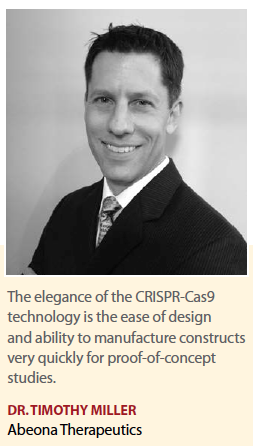 Many disease-causing mutations and disease-associated polymorphisms have already been identified as a result of gene editing, offering a multitude of targets, says Brian Zambrowicz, Ph.D., VP, functional genomics and chief of VelociGene operations, Regeneron Pharmaceuticals.
Many disease-causing mutations and disease-associated polymorphisms have already been identified as a result of gene editing, offering a multitude of targets, says Brian Zambrowicz, Ph.D., VP, functional genomics and chief of VelociGene operations, Regeneron Pharmaceuticals.
“Our company has the foundational belief that genetics drive a lot of diseases," he says. “If you believe in genetics, you can’t ignore a technology that provides an opportunity to modify genes to affect disease, and that’s why we’re very excited about CRISPR-Cas9. Gene editing has the potential to actually cure genetic disease." The company’s Regeneron Genetics Center (RGC) has built one of the world’s most comprehensive genetics databases, pairing the sequenced exomes and de-identified electronic health records of more than 100,000 people so far. Building upon Regeneron’s strengths in mouse genetics and genetics-driven drug discovery, this information will allow the company to elucidate, on a large scale, genetic factors that cause or influence a range of human diseases. The center conducts gene sequencing projects, functional biology, disease modeling and the translation of genetics findings into Regeneron’s preclinical and clinical pipelines. They are using our unique database and state-of-the-art analysis capabilities to identify new drug targets and therapeutic indications, to validate existing programs, and to build better-informed clinical trials.
“The Regeneron Genetics Center is churning out many new discoveries related to the genetics of human disease, providing additional leads on where exactly in DNA we might want to knock-out, repair or insert certain genetic sequences in order to attack diseases that have been historically difficult to address," Dr. Zambrowicz says. “The liver is a good place to start because it is the site of production for many proteins in the body and is a site amenable to current delivery methods."
He cites the example of transthyretin (TTR) amyloidosis, a severe disease with unmet medical need. Using CRISPR-Cas9 technology, Regeneron and its collaborator Intellia hope to edit the gene causing the dysfunctional TTR, but this is still very early research, Dr. Zambrowicz says.
Challenges and Obstacles
Dr. Wang says the most immediate and perhaps critical obstacle faced by researchers in the development of new therapies is the safety of novel gene-editing technology in humans.
“In practice, injecting genetically modified cells into patients or even directly modifying genes in the body could have unexpected adverse effects," she says. “For example, modifying immune cells to be more active in the fight against cancer could cause an increase in nonspecific immune activity as well, potentially resulting in attacks on healthy tissue. Early clinical trials are under way, but there is no way to determine how safe CRISPR-modified cells will be in humans until the studies are completed."
Dr. Fraser says there also remains work to ensure that we understand the potential for and impact of off-target effects.
“At present CRISPR can affect genes other than those intended," he says. “While specificity is a key benefit of CRISPR, work remains to be done to ensure that off-target editing is minimized. The one issue that is always raised when it comes to gene therapies in general and gene editing specifically is the potential for somatic vs. germline changes. While the technology is likely to be therapeutically limited to somatic gene changes, the potential for it to also work in germline cells and hence pass the changes on from generation to generation has important ethical implications."
The majority of gene editing technologies are complex, multi-component systems and depend on AAVs to deliver the editing therapeutic," Dr. Tzianabos says.
“As the field progresses in bringing these therapies to patients worldwide, we will need better tools to assess potential off-target effects and to solve for the inherent challenges associated with the complexity of multi-component delivery systems," he adds. “This includes the need for significantly improved manufacturing capacity of AAVs to meet the demands of these novel cures."
Dr. Falsetti explains gene editing has some technical challenges, including accuracy, delivery method, and development hurdles.
“Too many people have seen the movie Gattaca and think gene editing is about creating designer babies and GMOs, but that’s completely misguided," Dr. Falsetti says. “The conversation is more about its application for disease treatment. We are talking about modifying genes in diseased cells, not the whole organism."
Bottom line, Dr. Falsetti says, is that drug development is difficult, time consuming, and expensive. Developing a drug using a new technology platform — one that has never been used as a therapy in humans — is even more complex.
“We can expect the timeframe for development to be slower than we want as citizens, patients, doctors, and investors. That is basically the only thing that is certain," he concludes.
Another challenge is delivery, Dr. Smyth says.
“Currently, viruses deliver CRISPR-Cas9 into target cells, but more effective delivery methods are needed, particularly for use in tissues of living organisms," he says. “Before we see CRISPR therapies in clinical trials, there are other hurdles to overcome, including the usual drug development challenges concerning safety and manufacturing. Additionally, the ethics and policies surrounding the capability of CRISPR-Cas9 to edit the DNA of any cell will need to be addressed."
Dr. Miller says while the CRISPR technology has been successfully utilized in a petri dish in the lab, translating the power of this technological into clinical trials and commercial use will require creative approaches for delivering the CRISPR machinery in a way that does not fundamentally risk the rest of the cell or organ function.
“Gene therapy is all about delivery — the need to deliver the gene replacement or gene editing technology to the right place in the body, at the right time, with the right gene," he says.
On the commercial side, one challenge facing pharma/biotech companies is pricing, says Jillian Godfrey Scaife, principal, Trinity Partners.
“Traditionally, chronic therapies are paid for each month the product is used," she says. “How do you price a potentially one-time curative gene therapy? Pharma and biotech companies may need to develop innovative pricing models that amortize the cost of the curative gene therapy over the lifetime of the patient or the length of time during which the therapy provides a meaningful clinical benefit to the patient."
While representing a transformational addition to the suite of treatments for hereditary diseases, emerging gene therapies will challenge private and public payers’ coverage as well as coding and reimbursement systems across at least two dimensions, says Jon Glaudemans, managing director, Manatt, Phelps & Phillips.
First, he says, payers will need to compare the likely substantial cost of these curative therapies against possibly even-higher-priced alternate treatments.
Second, payers will need to make coverage, coding, and reimbursement decisions specific to the full suite of gene therapy’s associated services: appropriate screening and/or detection of the underlying condition; extraction of cells containing the defective gene; modification (editing) of the gene in question; re-introduction of the now-corrected gene into the patient; and medical monitoring and follow-up for months, if not years across multiple treatment settings.
“With many therapies delivered just after birth or in early childhood, employer-sponsored insurance and the joint federal-state Medicaid program will be critical payers for these therapies," he says.
Mr. Glaudemans says payment models for emerging gene therapies will rely on a mix of current and new approaches.
“One essential component of gene therapy — bone marrow transplantation (BMT) to introduce the edited genes back into the patient — has a current payment model," he says. “Another essential component — the gene editing process — has limited analogues within current payment models. Creating an adequate payment model that balances payers’ demand for cost-effectiveness and the reimbursement expectations of each of the contributors to a successful course of therapy — hospital, physician, laboratory, and innovator life-sciences companies — will be challenging. Removing this obstacle will be essential to market uptake and continued investment in the revolutionary technology to other therapeutic areas."
Dr. DeMeritt says a key obstacle that CRISPR will face as it enters mainstream use is convincing the public that it is responsible technology.
“If the national debate over genetically modified foods is any indication, the mere suggestion of genome manipulation has the potential to derail the broad use of this technology," he says. “As discussions of CRISPR expand beyond the walls of academia and increasingly enter the public sphere, I expect that it will begin to enter our political discourse at a more heightened and contentious level. In fact, anti-CRISPR ads have already started to pop up in Europe. The recently reported use of CRISPR by a Chinese lab to modify human embryos, as well as several other groups exploring similar avenues of research, will likely only hasten this impending political debate."
Dr. Wang also points to a legal obstacle: an ongoing battle over the patent for CRISPR technology, which has the potential to severely limit future use of the tool. The battle is over just who owns the rights to the cutting-edge CRISPR-Cas9 technology.
In 2012, a team led by molecular biologist Dr. Jennifer Doudna of the University of California, Berkeley, reported that it had reprogrammed CRISPR–Cas9 to cut isolated DNA at sites of their choosing. Then, in early 2013, several groups, including one led by synthetic biologist Feng Zhang of the Broad Institute of MIT and Harvard, reported that CRISPR–Cas9 also worked in living eukaryotic cells, including human cells.
Since January, these two teams have been making their cases to patent judges.
“The eventual patent owners could demand prohibitive licensing fees for use of the technology, even when used for academic purposes," she says. (PV)
~~~~~~~~~~~~~~~~~~~~~~~~
Gene Editing Technologies
Gene editing technologies aim to use “molecular scissors" to make a cut in the genome and then DNA can be inserted, removed, or replaced. There are currently four families of engineered nucleases being used:
1. Zinc finger nucleases (ZFNs)
2. Transcription activator-like effector nucleases (TALENs)
3. The CRISPR-Cas system
4. Engineered meganuclease re-engineered homing endonucleases



















